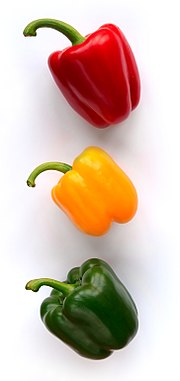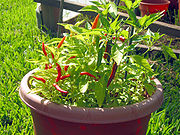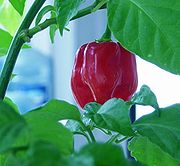
The
habanero chile (
Capsicum chinense Jacquin) (sometimes incorrectly spelled "habañero") is one of the most intensely spicy species of
chili peppers of the
Capsicum genus. Unripe habaneros are green, and they color as they mature. Common colors are orange and red, but white, brown, and pink are also seen. Typically a ripe habanero is 2–6 centimetres (0.79–2.4 in) long.
The habanero chili pepper most likely originated in the Yucatán Peninsula and its coastal regions. Upon its discovery by Europeans, it was rapidly disseminated to other adequate climate areas of the world, to the point that 18th-century taxonomists mistook China for its place of origin and called it "Capsicum chinense"—the Chinese pepper. In more recent times, and after research, it is believed to have originated in the Mexican state of Yucatán.
The chili's name is derived from the name of the Cuban city of La Habana, which is known as Havana in English. Although it is not the place of origin, it was frequently traded there.
Today, the crop is most widely cultivated in the Yucatán Peninsula of Mexico. Other modern producers include Belize, Panama, Costa Rica, and some United States states including Texas, Idaho, and California. While Mexico is the largest consumer of this spicy ingredient, its flavor and aroma have become increasingly popular all over the world.
Habaneros are an integral part of Yucatecan food. Habanero chilies accompany most dishes in Yucatán, either in solid or purée/salsa form.
The Scotch bonnet is often compared to the habanero since they are two varieties of the same species but have different pod types. Both the Scotch bonnet and the habanero have the characteristic thin, waxy flesh. They have a similar heat level and flavor. Although both varieties average around the same level of heat, the actual degree of "heat" varies greatly with genetics, growing methods, climate, and plant stress.
Recently, the habanero's heat, its fruity, citrus-like flavor, and its floral aroma have made it a popular ingredient in hot sauces and spicy foods. In some cases, particularly in Mexico, habaneros are placed in tequila or mezcal bottles for a period ranging from several days, to several weeks, in order to make a spiced version of the drink.
Habaneros thrive in hot weather. As with all peppers, the habanero does well in an area with good morning sun and in soil with an acidity level around 5-6 pH. The habanero should be watered only when dry. Overly moist soil and roots will produce bitter-tasting peppers.
Habanero bushes are good candidates for a container garden. They can live many years in pots or other growing containers at proper temperature.
The habanero is a perennial flowering plant, meaning that with proper care and growing conditions, it can produce flowers (and thus fruit) for many years. However, in temperate climates it is treated as an annual when planted in the ground, dying each winter and being replaced the next spring. In tropical and sub-tropical regions, the habanero, like other chiles, will produce year round. As long as conditions are favorable, the plant will set fruit continuously.
Black Habanero is an alternative name often used to describe the dark brown variety of Habanero chillies. Seeds have been found that are thought to be over 7000 years old. It has an exotic and unusual taste. Small slivers used in cooking can have a dramatic effect on the over-all dish. Gourmets delight in its fiery heat and unusual flavour.
They take considerably longer to grow than other Habanero chilli varieties but are considered by many to be worth the wait. In a dried form they can be preserved for long periods of time and can be reconstituted in water then added to sauce mixes. Previously known as Habanero Negra, or by their
Nahuatl name, they were translated into English by spice traders in the 19th century as "Black Habanero". The word "Chocolate" was derived from the Nahuatl Indian word, "xocolatl", and was used in the description as well, but it proved to be unpronounceable to the British traders, so it was simply named "Black Habanero".
Several growers have attempted to selectively breed habanero plants to produce hotter, heavier, and larger peppers. The Naga Jolokia is a chili that has a very high Scoville rating that reaches up to 1,041,365 and is often mistaken for a cultivar of the habanero pepper, although it is actually its own species. Most habaneros will rate between 200,000 and 300,000 Scoville units.
In 2004 researchers in Texas created a mild version of the habanero pepper retaining the aroma and flavor of the traditional habanero pepper. The milder version was obtained by crossing the
Yucatán habanero pepper with a heatless habanero from
Bolivia over several generations. These mild habaneros are expected to be widely available to consumers in the future.
Scoville Rating: 100000-350000
 The Lemon drop is a hot, citrus-flavored pepper is a popular seasoning pepper in Peru where it is known as Kellu Uchu. It is also known in the anglophone world as 'Hot lemon' or 'Lemon Drop'. The bright yellow, crinkled, cone-shaped fruits are about 2-1/2" long and 1/2" wide and mature from green to yellow approximately 100 days after transplanting (Long season) have fewer seeds than the average pepper, containing than 15 seeds on average. The plant is vine like typically reaching a height of about 3 ft. Like other baccatum species this pepper was practically unknown in the West until the early 1990s, but are now gaining wide scale popularity.
The Lemon drop is a hot, citrus-flavored pepper is a popular seasoning pepper in Peru where it is known as Kellu Uchu. It is also known in the anglophone world as 'Hot lemon' or 'Lemon Drop'. The bright yellow, crinkled, cone-shaped fruits are about 2-1/2" long and 1/2" wide and mature from green to yellow approximately 100 days after transplanting (Long season) have fewer seeds than the average pepper, containing than 15 seeds on average. The plant is vine like typically reaching a height of about 3 ft. Like other baccatum species this pepper was practically unknown in the West until the early 1990s, but are now gaining wide scale popularity.






























